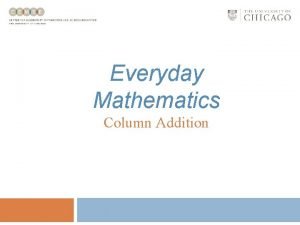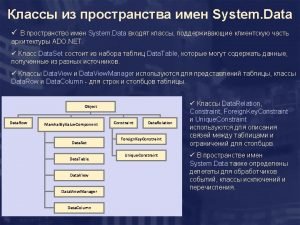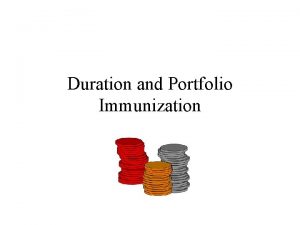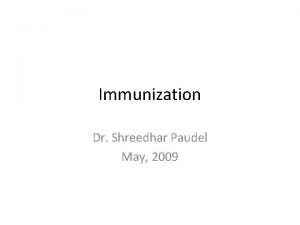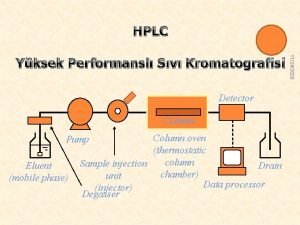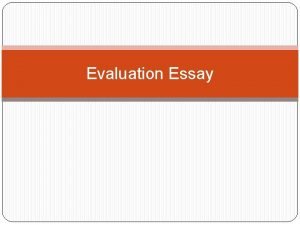A Column for 16 YearOlds on the Immunization
















































- Slides: 48

A Column for 16 -Year-Olds on the Immunization Schedule: An Opportunity to Address Critically Low Immunization Rates SAUS. MENID. 19. 01. 0213 4/19

ACIPa Schedule Emphasizes the Importance of Immunizations at 16 Years of Age 1 Range of recommended ages for all children Range of recommended ages for catch-up immunization a ACIP = Advisory Committee on Immunization Practices. Range of recommended ages for certain high-risk groups Range of recommended ages for non-high-risk groups that may receive vaccine, subject to individual clinical decision making No recommendation Adapted from the ACIP Recommended Child and Adolescent Immunization Schedule for Ages 18 Years or Younger, United States, 2019. To see notes from the ACIP Schedule, see Reference 1 below. Reference: 1. Centers for Disease Control and Prevention (CDC). Recommended child and adolescent immunization schedule for ages 18 years or younger, United 2 States, 2019. https: //www. cdc. gov/vaccines/schedules/downloads/child/0 -18 yrs-child-combined-schedule. pdf. Accessed February 12, 2019.

Critical Issue: Low Vaccination Coverage Leaves Adolescents Underprotected 3

Substantial Gaps Exist in Vaccination Rates Among 13 - Through 17 -Year-Olds 1 -3 2017 Immunization Rates in Adolescents 89 Tdap ≥ 1 dose 85 Men. ACWY ≥ 1 dose 44 Vaccine Men. ACWY ≥ 2 dosesa 69 HPV ≥ 1 dose, females Healthy People (HP) 2020 Goal: 80%d 53 HPV UTDb, females 63 HPV ≥ 1 dose, males HPV UTDb, males 44 Influenzac 47 0 10 20 30 40 HP Goal: 70% 50 60 70 80 90 100 Estimated vaccination coverage (%) • No Healthy People goal has been established for the second dose of quadrivalent meningococcal conjugate vaccine (Men. ACWY) or the first dose of human papillomavirus (HPV) vaccine. a Second-dose rate for Men. ACWY based on 17 -year-olds. b HPV up-to-date (UTD) rate for series completion. c 2017 -2018 influenza season. d Healthy People goal is for 1 dose of tetanus, diphtheria, and acellular pertussis (Tdap) vaccine, 1 dose of Men. ACWY, and 2 or 3 doses of HPV vaccine as recommended. References: 1. CDC. MMWR. 2018; 67(33): 909 -917. 2. CDC. https: //www. cdc. gov/fluvaxview/coverage-1718 estimates-children. htm. Accessed January 31, 2019. 3. Healthy People 2020. https: //www. healthypeople. gov/2020/topics-objectives/topic/immunization-and-infectious-diseases/objectives. Accessed January 31, 2019. 4

Contributing Factors to Low Immunization Rates in Older Adolescents 1 -7 § Lower rate of preventive health care visits – 3 times more preventive care visits for adolescents 11 -14 years of age than for older adolescents § Parents less aware of need for preventive care in older age group § Lack of school requirements for vaccination – 16 states require Men. ACWY dose 2; 3 jurisdictions require HPV vaccination § Immunizations for older teens may be a lower priority for families and health care providers compared with immunizations for younger children References: 1. Rand CM, et al. Arch Pediatr Adolesc Med. 2007; 161(3): 252 -259. 2. Gowda C, et al. BMC Public Health. 2012; 12: 509. 3. Immunization Action Coalition. http: //www. immunize. org/laws. Accessed January 29, 2019. 4. Adolescent Immunization Initiative. http: //www. 16 yearoldvisit. org/download/white-paper. pdf. Accessed January 29, 2019. 5. Nordin JD, et al. Ann Fam Med. 2010; 8(6): 511 -516. 6. Tsai Y, et al. J Pediatr. 2014; 164: 625 -630. 7. Wong CA, et al. J Adolesc Health. 2013; 53(4): 492 -497. 5

Many Competing Priorities When Seeing Older Adolescents 1 School (friendships, college transition, etc) Mental health (depression, anxiety, etc) Drugs, alcohol, and tobacco Nutrition and exercise General physical health Sexual health and pregnancy, including sexually transmitted diseases Reference: 1. Broder KR, et al. Pediatrics. 2008; 121(suppl 1): S 25 -S 34. Immunizations Safe driving 6

Impact of Low Immunization Rates: Millions of Adolescents Are Potentially Underprotected From Devastating Diseases Meningococcal Disease HPV Influenza Approximately 21% of the nearly 2000 deaths from meningococcal disease that occurred during 1999 -2015 were in the 15 - through 24 -year-old age group. 1 -17 Half of the 14 million new HPV infections that occur each year in the United States are in the 15 - through 24 -year-old age group, putting these adolescents and young adults at risk for cervical and other cancers later in life. 19 Approximately 25% of pediatric influenza deaths in the 20152016, 2016 -2017, and 2017 -2018 flu seasons combined were among adolescents 12 through 17 years of age. 20 Case fatality rates are 10% to 15%, and up to 19% of survivors suffer longterm consequences of the disease. 18 References: 1. Hoyert DL, et al. Natl Vital Stat Rep. 2001; 49(8): 1 -116. 2. Miniño AM, et al. Natl Vital Stat Rep. 2002; 50(15): 1 -120. 3. Arias E, et al. Natl Vital Stat Rep. 2003; 52(3): 1 -116. 4. Kochanek KD, et al. Natl Vital Stat Rep. 2004; 53(5): 1 -116. 5. Hoyert DL, et al. Natl Vital Stat Rep. 2006; 54(13): 1 -120. 6. Miniño AM, et al. Natl Vital Stat Rep. 2007; 55(19): 1 -120. 7. Kung H-C, et al. Natl Vital Stat Rep. 2008; 56(10): 1 -124. 8. Heron M, et al. Natl Vital Stat Rep. 2009; 57(14): 1 -136. 9. Xu J, et al. Natl Vital Stat Rep. 2010; 58(19): 1 -136. 10. Miniño AM, et al. Natl Vital Stat Rep. 2011; 59(10): 1 -126. 11. Kochanek KD, et al. Natl Vital Stat Rep. 2011; 60(3): 1 -166. 12. Murphy SL, et al. Natl Vital Stat Rep. 2013; 61(4): 1 -117. 13. Kochanek KD, et al. Natl Vital Stat Rep. 2015; 63(3): 1 -120. 14. Murphy SL, et al. Natl Vital Stat Rep. 2015; 63(9): 1 -117. 15. Xu J, et al. Natl Vital Stat Rep. 2016; 64(2): 1 -119. 16. Kochanek KD, et al. Natl Vital Stat Rep. 2016; 65(4): 1 -122. 17. Murphy SL, et al. Natl Vital Stat Rep. 2017; 66(6): 1 -75. 18. CDC. MMWR. 2013; 62(RR-2): 1 -28. 19. CDC. MMWR. 2014; 63(RR-5): 1 -30. 20. CDC. http: //gis. cdc. gov/GRASP/Fluview/ Ped. Flu. Death. html. Accessed January 29, 2019. 7

Vaccines in the Adolescent 16 -Year-Old Immunization Platform 1 -5 CDC ACIP Recommendations for the Healthy Adolescent Vaccine 11 -12 years 13 -15 years 16 years 17 -18 years Category A recommendation Men. ACWY 1 st dose Tdap 1 dose 2 - or 3 -dose series Annual Influenza (seasonally) Category B recommendation HPVa Meningococcal Bb Catch-up immunization if not already vaccinated 2 nd dose Catch-up immunization if not already vaccinated Catch-up immunization if not already vaccinated Annual (seasonally) Based on individual clinical decision making for patients 16 -23 years of age. Preferred age for vaccination is 16 -18 years. a In October 2016, the ACIP approved a 2 -dose HPV series for healthy persons who start the series before age 15 years and a 3 -dose HPV series for those who start the series at age 15 years and older; 3 doses are still recommended for immunocompromised persons regardless of age at vaccine initiation; b A 2 -dose Men. B series is recommended for healthy adolescents not at increased risk for meningococcal disease. References: 1. CDC. https: //www. cdc. gov/vaccines/schedules/downloads/child/0 -18 yrs-child-combined-schedule. pdf. Accessed February 12, 2019. 2. CDC. MMWR. 2016; 65(49): 1405 -1408. 3. Advisory Committee on Immunization Practices (ACIP). https: //www. cdc. gov/vaccines/acip/meetings/downloads/min-archive/ min-2016 -10. pdf. Accessed January 29, 2019. 4. Auslander B, et al. J Adolesc Health. 2017; 60(4): 475 -476. 5. American Academy of Pediatrics Committee on Infectious Diseases. Pediatrics. 2016; 138(3): e 20161890. 8

The Broad Health Benefits of a Platform at 16 Years of Age 9

Benefits of an Adolescent Immunization Platform at 16 Years of Age 1 -3 Creates an expectation for routine vaccination at this age among parents and health care professionals Encourages health care providers to review Men. ACWY, Men. B, and, during flu season, influenza immunization Provides platform to catch up on missed vaccinations and the complete vaccination series (HPV, Tdap, etc), and assess for vaccinations based on high-risk conditions The potential benefits extend well beyond immunization… References: 1. Auslander B, et al. J Adolesc Health. 2017: 60(4): 475 -476. 2. National Foundation for Infectious Diseases. http: //www. adolescentvaccination. org/ resources/call-to-action-adolescent-vaccination-challenges. pdf. Accessed January 29, 2019. 3. Adolescent Immunization Initiative. http: //www. 16 yearoldvisit. org/ download/white-paper. pdf. Accessed January 29, 2019. 10

Benefits of an Adolescent Immunization Platform at 16 Years of Age 1 -3 (cont) Creates the opportunity to continue to provide preventive health services targeted to the health needs of these adolescents, including screening and psychosocial guidance to prevent risky behaviors (eg, substance abuse and unsafe driving) Can empower older teens to embrace a greater role in their own health Offers what may be a last opportunity for an adolescent to be immunized before Vaccines for Children Program (VFC) coverage ends and the adolescent leaves home References: 1. Auslander B, et al. J Adolesc Health. 2017: 60(4): 475 -476. 2. National Foundation for Infectious Diseases. http: //www. adolescentvaccination. org/ resources/call-to-action-adolescent-vaccination-challenges. pdf. Accessed January 29, 2019. 3. Adolescent Immunization Initiative. http: //www. 16 yearoldvisit. org/ download/white-paper. pdf. Accessed January 29, 2019. 11

Support for an Adolescent Immunization Platform at 16 Years of Age § Society for Adolescent Health and Medicine – Position Statement: Establishing an Immunization Platform for 16 -Year-Olds in the United States 1 § National Foundation for Infectious Diseases – Call to Action: Addressing New and Ongoing Adolescent Vaccination Challenges 2 § American Academy of Family Physicians Foundation – Highlight on VACCINATIONS 4 TEENS Resource Library 3 § Adolescent Immunization Initiative – Rationale for an Immunization Platform at 16 Years of Age 4 References: 1. Auslander B, et al. J Adolesc Health. 2017; 60(4): 475 -476. 2. National Foundation for Infectious Diseases. http: //www. adolescentvaccination. org/resources/call-to-action-adolescentvaccination-challenges. pdf. Accessed January 29, 2019. 3. American Academy of Family Physicians Foundation. https: //www. aafpfoundation. org/content/dam/foundation/documents/what-weredoing/awards-grants/hov 4 t/Resource. Library/HOV 4 T_resource_library_guidance. pdf. Accessed January 29, 2019. 4. Adolescent Immunization Initiative. http: //www. 16 yearoldvisit. org/ download/white-paper. pdf. Accessed January 29, 2019. 12

Implementing the Platform for 16 -Year-Olds 13

Key Elements of the Adolescent 16 -Year-Old Immunization Platform § The platform is recognition at the practice level that 16 years is a priority age and that vaccination is a priority topic for that visit due to the ACIP schedule and specific vaccination requirements at 16 years of age 1 – Other preventive care should occur at this visit (with vaccination a priority among competing objectives) – Immunizations are a reason (leverage) to bring adolescents into the office for this more comprehensive care 2 § The platform encompasses all the steps that health care providers and their practices should take before and during that 16 -year-old visit to make certain the patient receives all appropriate services 1 – Demands a proactive approach References: 1. Adolescent Immunization Initiative. http: //www. adolescentvaccination. org/related-links/aii-implementation-whitepaper. pdf. Accessed March 15, 2019. 2. Broder KR, et al. Pediatrics. 2008; 121(suppl 1): S 25 -S 34. 14

Key Elements of the Adolescent 16 -Year-Old Immunization Platform 1 (cont) Proactive approach • Measure adolescent immunization rates • and set goals for improvement Identify and reach out to vaccine-eligible adolescent patients (eg, remind and recall) • Adopt a team approach and a routine • Foster a culture of prevention (eg, • • vaccination workflow (eg, use standing orders) Capitalize on patient encounters (eg, check immunization status at every visit) schedule annual preventive health visits for all teens) Educate families about the milestone 16 -year-old visit well in advance Well-care services with immunizations as a priority • Review vaccines and administer as appropriate: Men. ACWY, Men. B, influenza, catch-up (eg, HPV and Tdap vaccines), vaccinations for high-risk conditions • Perform annual screenings and physical examination (eg, sexually transmitted infections, obesity) • Provide psychosocial assessment and counseling (eg, depression, sexual health, safe driving, drugs, alcohol, tobacco, vaping, nutrition, exercise, sleep) Preparation for transition to young adulthood • Educate teens about the importance of preventive care throughout life • Empower teens to play a greater role in their own wellness, including following immunization recommendations • Provide practical information, such as self-care management (eg, give the patient of copy of his or her care plan) Reference: 1. Adolescent Immunization Initiative. http: //www. adolescentvaccination. org/related-links/aii-implementation-whitepaper. pdf. Accessed March 15, 2019. 15

6 Proactive Steps to Implementing the Platform Measure immunization rates of your adolescent population Identify and reach out to vaccine-eligible adolescents Adopt a team approach and a routine vaccination workflow Capitalize on opportunities to provide the platform services Foster a culture of prevention throughout the office Educate families about the 16 -year-old visit far in advance 16

Measure Immunization Rates of Your Adolescent Population § Assess how well your practice is actually doing at immunizing adolescents 1, 2 § Determine the rate for the entire population–not just for those adolescents who are coming in § Methods – – – Immunization Information System (IIS) Electronic Medical Record (EMR) system Chart audit Claims data review Assessment, Feedback, Incentives, and e. Xchange (AFIX) • www. cdc. gov/vaccines/programs/afix/index. html References: 1. CDC. Epidemiology and Prevention of Vaccine-Preventable Diseases. (The Pink Book). 2015: 33 -46. 2. National Vaccine Advisory Committee. Pediatrics. 2003; 112(4): 958 -963. 17

Identify and Reach Out to Vaccine-Eligible Patients § Don’t rely on pre-college visits and sports physicals to bring teens in enroll in college 1 – 42% of high school students do not play on a sports team 2, 3 § Search immunization registries and your own patient records for unvaccinated and undervaccinated teens 4 § Remind and recall (it works!)5 Hero Images/Getty Images – 30% of high school graduates do not References: 1. US Department of Labor. https: //www. bls. gov/news. release/hsgec. nr 0. htm. Accessed January 29, 2019. 2. CDC. MMWR. 2016; 65(SS-6): 1 -174. 3. National Center for Education and Statistics. https: //nces. ed. gov/programs/digest/d 15/tables/dt 15_201. 20. asp. Accessed January 29, 2019. 4. Bernstein HH, et al. Pediatrics. 2017; 139(3): e 20164187. 5. Community Preventive Services Task Force. https: //www. thecommunityguide. org/sites/default/files/assets/Vaccination-Client. Reminders. pdf. Accessed January 29, 2019. 18

§ Use standing orders to immunize § Designate a vaccine champion or team of champions 1, 2 Courtesy of Immunization Action Coalition § Establish a vaccination workflow with specifically assigned staff responsibilities Macrovector. Freepik. com Adopt a Team Approach References: 1. American Academy of Family Physicians. http: //www. aafp. org/dam/AAFP/documents/patient_care/immunizations/office-champions-final-reportadolescent. pdf. Accessed January 29, 2019. 2. Unity Consortium. http: //www. unity 4 teenvax. org/wp-content/uploads/2017/05/Unity-Whitepaper-FINAL-May 2017. pdf. Accessed January 29, 2019. 19

Capitalize on Opportunities to Provide the Platform Services Consider every patient visit an opportunity to immunize and provide other preventive care PREPARE CONVERT PROMPT Check each patient’s immunization status ahead of scheduled visits 1 Change non-wellness appointments to a platform visit when possible 2 Use EMR alerts at the point of care to catch patients who need immunizing 3 References: 1. Immunization Action Coalition. https: //www. give 2 mcv 4. org/wp-content/uploads/2015/07/Toolkit-Top-10 -Ways. pdf. Accessed March 15, 2019. 2. Adolescent Immunization Initiative. http: //www. adolescentvaccination. org/related-links/aii-implementation-white-paper. pdf. Accessed March 15, 2019. 3. CDC. Epidemiology and Prevention of Vaccine-Preventable Diseases. (The Pink Book). 2015: 33 -46. 20

Foster a Culture of Prevention § Create an office culture that values well care for adolescents and emphasizes the importance of immunizations § Establish expectations of compliance among parents and patients 1 – Schedule annual preventive health visits for all adolescents – Encourage parents to proactively schedule the 16 -year-old visit Many parents expect practices to inform them when the teen’s next vaccine is due, such as by scheduling a vaccine appointment, mentioning vaccination during a visit, or sending a reminder 2 References: 1. Middleman AB. J Adolesc Health. 2007; 41(2): 109 -118. 2. CS Mott Children’s Hospital. http: //www. mottnpch. org/reports-surveys/parents-not-keeping -teen-vaccines. Accessed January 29, 2019. 21

Educate Families About the 16 -Year-Old Visit Far in Advance § Start at the 11 - to 12 -year-old visit § Provide short, clear, and frequent messages about the 16 -year-old visit § Talk about the severity of vaccine-preventable diseases § Post content on the practice’s website and social media channels Ben Pipe Photography/Getty Images § Emphasize that 16 years is a milestone age for immunizations and other preventive care 22

Prepare Adolescents as They Transition to Young Adulthood § Set the stage for 16 -year-olds to take ownership of their health care, including vaccinations – Work with parents and directly with the teen 1 § Provide practical information to aid the transition to adult care 2 – Eg, who to call about insurance issues, how to fill prescriptions § Suggest tools to help the adolescent stay on track Sturti/Getty images – Eg, vaccine tracker cell phone app References: 1. American Academy of Pediatrics. https: //www. aap. org/en-us/about-the-aap/aap-press-room/pages/American-Academy-of-Pediatrics-Urges. Improvement-in-Teen-Vaccination-Rates. aspx. Accessed February 4, 2019. 2. Got Transition. http: //www. gottransition. org/resource. Get. cfm? id=208. Accessed January 29, 2019. 23

Be the Catalyst for Change § Immunization rates for older adolescents are critically low for Men. ACWY dose 2, influenza vaccine, and HPV vaccine series completion § To help address this issue, the ACIP added a separate column for 16 years of age to the immunization schedule, thus identifying the 16 -year-old visit as the standard of care § This visit is also a prime opportunity to provide other preventive services as well § Take steps before and during the 16 -year-old visit to make certain all 16 -year-olds in the practice receive all appropriate services § Measure your practice’s vaccination rates to get a true baseline, and set goals for improvement Educate. . . Spread the word…Be proactive 24

Backup Slides (Optional Use) 25

Case Study: The 16 -Year-Old Visit § Andrew’s parents receive a reminder postcard from your office, noting that he is due for an annual checkup at 16 years of age § When they call to set up an appointment, the staff schedules enough time to allow for a comprehensive well visit § A day before the visit, the medical assistant checks on Andrew’s immunization history, consulting both the practice’s electronic health record and the state immunization information system – The review includes assessment of the need for any catch-up vaccinations (eg, HPV, Tdap, varicella, hepatitis B) – Andrew has no medical conditions that warrant nonroutine vaccinations (eg, pneumococcal vaccine for patients with heart disease) Moxie Productions/Getty Images 26

Case Study: The 16 -Year-Old Visit (cont) Review of Vaccinations § Andrew is not only due for the second dose of Men. ACWY, he has not received any dose of HPV vaccine; in addition, it is flu season § You discuss with Andrew and his dad the importance of the second dose of Men. ACWY, possible vaccination with Men. B vaccine, and catch-up vaccination for HPV – Andrew asks, “Why do I need HPV vaccine? My girlfriend got that vaccine. ” – You emphasize that HPV vaccine prevents cancer and explain the need for vaccination in both sexes § You also emphasize the importance of receiving the flu vaccine every year § After you strongly recommend that Andrew receive the package of vaccines he is due for, he and his dad agree to vaccination – A nurse will administer the vaccines at the end of the visit and see that appointments are scheduled for Andrew to come back for doses 2 and 3 of HPV vaccine 27

Case Study: The 16 -Year-Old Visit (cont) General Preventive Care § You conduct a physical exam and screenings according to preventive health guidelines § You assess and provide guidance for psychosocial issues, including emotional health, substance use, and driving habits now that Andrew is learning to drive Look to the Future § Before the visit is over, you take time to talk about the transition to young adulthood and the importance of preventive medicine throughout life § You encourage Andrew to embrace a greater role in his own wellness—present and future—including adhering to vaccination recommendations such as annual flu vaccine § You recommend to Andrew’s dad the phone app Thrive—Teen/Young Adult Health Resources, Information & Vaccine Education (available at www. unity 4 teenvax. org/ resources/thrive-app/), which helps parents prepare teens to take ownership of their health 28

Talking to Teens About Vaccines—and Health 1, 2 § Consider the adolescent health visit an opportunity to foster and maintain relationships with both the parent and the adolescent § At each visit, include time for the physician and adolescent to converse without the parent present – As appropriate, emphasize confidentiality so the adolescent can feel comfortable sharing perspectives on all health concerns Jamie Grill/Getty Images § Keep in mind the framework of adolescent cognitive development – A time when youngsters are developing reasoning skills and abstract thinking – Seeking independence, the teen may not perceive consequences of risk-taking behavior § Avoid information overload – “Chunk and check” References: 1. Bernstein HH, et al. Pediatrics. 2017; 139(3): e 20164187. 2. Bernstein HH, et al. Pediatrics. 2017; 139(3): e 20164186. 29

Talking to Teens About Vaccines—and Health 1, 2 (cont) § Strongly endorse all universally recommended vaccines as important for adolescent health § Use motivational interviewing techniques – Ask open-ended questions; encourage self-reflection – Affirm the patient’s efforts and strengths – Assess readiness to change behaviors Hero Images/Getty Images § Goal: Allow adolescent and parent to conclude for themselves that immunization is important by having them reflect on the need to protect the teen against vaccine-preventable diseases § Each visit should allow for discussion of adolescent health issues in general References: 1. Bernstein HH, et al. Pediatrics. 2017; 139(3): e 20164187. 2. Bernstein HH, et al. Pediatrics. 2017; 139(3): e 20164186. 30

The Immunization Neighborhood: Collaborating With Others in the Community § All health care professionals can work together to see that adolescents receive all recommended vaccinations on schedule 1, 2 – The immunization neighborhood includes primary care providers, specialists, pharmacists, school nurses, public health professionals, and others – Expands adolescents’ access to immunizations—more places, more hours § Challenges – Need to be able to transmit information across health care access points 3 – Adolescent still needs to visit medical home for annual preventive care visit • Immunizers could be trained to encourage teens and parents to schedule a comprehensive primary care visit once vaccine requirements have been met 4 References: 1. Klein J, et al. J Adolesc Health. 2017; 61(5): 541 -543. 2. Bernstein HH, et al. Pediatrics. 2017; 139(3): e 20164187. 3. Szilagyi PG, et al. Pediatrics. 2008; 121(suppl 1): S 15 -S 24. 4. Clark SJ, et al. Public Health Manag Pract. 2018; 24(6): 554 -557. 31

Resources on Adolescent Immunization and the 16 -Year-Old Visit § Immunization Action Coalition (IAC) www. immunize. org, www. Give 2 Men. ACWY. org § National Foundation for Infectious Diseases (NFID) www. adolescentvaccination. org § National Association of School Nurses (NASN) Stats 4 Vax: Improving Teen Vaccination Rates One School Nurse at a Time www. nasn. org/nasn/programs/educational-initiatives/stats 4 vax § American Academy of Family Physicians (AAFP) Foundation Highlight on VACCINATIONS 4 TEENS Resource Library Courtesy of Immunization Action Coalition 32

Resources on Adolescent Immunization and the 16 -Year-Old Visit (cont) § UNITY Consortium – United for Adolescent Vaccination www. unity 4 teenvax. org § CDC Preteen and Teen Immunization Resources www. cdc. gov/vaccines/partners/teens/index. html § Association of Immunization Managers (AIM) www. immunizationmanagers. org/page/adolescents § Adolescent Immunization Initiative (AII) www. 16 yearoldvisit. org Courtesy of UNITY § National Alliance to Advance Adolescent Health www. gottransition. org 33

Stats 4 Vax: Improving Teen Vaccination Rates One School Nurse at a Time § Stats 4 Vax: resource library to help high school nurses improve teen vaccination rates § Materials that nurses can tailor to needs of their student population, including: – Letter to parents, sent home with students, encouraging vaccination – Talking points to help proactively discuss vaccination with students 16 and 17 years of age – Document outlining opportunities to engage with parents and teens about the importance of teen vaccination – Educational content for use on social media, in school newsletters, and on school website www. nasn. org/nasn/programs/educationalinitiatives/stats 4 vax 34

Rick Lowe/Getty Images <1 year of age Kid. Stock/Getty Images 16 years of age through early 20 s Terry Vine/Getty Images Peak Risk Periods for Meningococcal Disease 1, 2 ≥ 65 years of age Meningococcal Disease Incidence by Age, US, 2007 -2016 CDC; National Notifiable Diseases Surveillance System References: 1. CDC. MMWR. 2013; 62(RR-2): 1 -28. 2. CDC. https: //www. cdc. gov/meningococcal/surveillance/index. html. Accessed January 29, 2019. 35

Why Boost at 16 Years of Age? § Antibody persistence studies indicate that protective levels of circulating antibody decline 3 to 5 years after a single dose of Men. ACWY 1 -3 § Vaccine effectiveness case−control study suggests that many adolescents are not protected 5 years after vaccination 1, 4 “[A] single dose of meningococcal conjugate vaccine administered at age 11 or 12 years is unlikely to protect most adolescents through the period of increased risk at ages 16 through 21 years”─ACIP 1 References: 1. CDC. MMWR. 2013; 62(RR-2): 1 -28. 2. Keyserling H, et al. Arch Pediatr Adolesc Med. 2005; 159(10): 907 -913. 3. Vu DM, et al. J Infect Dis. 2006; 193(6): 821 -828. 4. Cohn AC, et al. Pediatrics. 2017; 139(2): e 20162193. 36

Waning Antibody Protection in Serogroup C: The Need for Boosting 1 99. 6% Percentage with h. SBA titer ≥ 1: 8 100 80 60 40 44. 2% 20 0 4 -6 years after 1 dose 28 days after booster dose h. SBA = Serum bactericidal assay using human complement. Reference: 1. Robertson CA, et al. Vaccine. 2016; 34: 5273 -5278. 37

Estimated vaccination rate (%) Substantial Gaps Exist in Vaccination Rates Among 13 - Through 17 -Year-Olds 1, 2 2017 Immunization Rates in Adolescents 100 80 85 89 89 92 92 Tdape ≥ 1 dose Varicellaf ≥ 2 doses Hepatitis B ≥ 3 doses MMRg ≥ 2 doses 60 40 44 20 53 44 [VALUE] 0 Men. ACWYa ≥ 1 dose Men. ACWY ≥ 2 dosesb HPVc UTD, females HPVc UTD, males Influenzad 15% unprotected 56% underprotected 47% under- or unprotected 56% under- or unprotected 53% unprotected Catch-up needed for 11%, 8%, and 8% of adolescents, respectively a Men. ACWY = Quadrivalent meningococcal conjugate vaccine; b Second-dose rate based on 17 -year-olds; c HPV = Human papillomavirus vaccine up-to-date (UTD) rate for series completion; d 2017 -2018 influenza season; e Tdap = Tetanus, diphtheria, and acellular pertussis; f Among adolescents with no history of varicella; g MMR = measles, mumps, rubella vaccine. References: 1. CDC. MMWR. 2018; 67(33): 909 -917. 2. CDC. https: //www. cdc. gov/fluvaxview/coverage-1718 estimates-children. htm. Accessed January 29, 2019. 38

Annual Well-Care Visits for Adolescents Lag Far Behind Those for Children 1 § National quality measure for adolescents: at least 1 comprehensive well-care visit with a primary care practitioner or ob/gyn in a given year § In 2017, roughly half of adolescents in health plans did not have an annual well-care visit 2017 HEDISa Data (percentage with at least 1 visit per year) Type of visit Commercial HMOb Commercial PPOc Medicaid HMO Adolescent well-care (12 -21 years of age) 48% 45% 53% Well-child (3 -6 years of age) 77% 75% 73% a HEDIS = Healthcare Effectiveness Data and Information Set (HEDIS); b HMO = health maintenance organization; c PPO = preferred provider organization. Reference: 1. National Commission on Quality Assurance (NCQA). http: //www. ncqa. org/report-cards/health-plans/state-of-health-care-quality/2017 -table-ofcontents/child-well-care-visits. Accessed February 1, 2019. 39

How Electronic Health Records (EHRs) Can Help Increase Adolescent Immunization Rates § EHR benefits include – Easy tracking of immunization records of patients in the practice 1 – Programmed clinical alerts, reminders, and recalls for missing, delayed, or due vaccinations 1, 2 – Tie-ins to immunization information systems and their wealth of data on individual vaccination histories 1 – Thorough documentation that facilitates accurate coding and billing 1, 2 § Challenges – Need for mechanisms to protect confidentiality of adolescents 3 -5 – Not all EHR systems can communicate with all other EHRs, labs, and immunization information systems References: 1. Bernstein HH, et al. Pediatrics. 2017; 139(3): 20164187. 2. Au L, et al. Appl Clin Inform. 2010; 1(3): 221 -231. 3. Society for Adolescent Health and Medicine. J Adolesc Health. 2014; 54(4): 487 -490. 4. American College of Obstetricians and Gynecologists. Obstet Gynecol. 2014; 123(5): 1148 -1150. 5. Stablein T, et al. J Adolesc Health. 2018; 62(5): 577 -582. 40

A Health System’s Approach to Improving Adolescent Immunization 1 § Denver Health used low-cost, system-wide standard procedures, including: – Educating providers to present the 3 vaccines – – as a standard “bundle” of adolescent immunizations, with a strong provider recommendation for all Offering vaccines at every visit, whether acute or preventive Using immunization registries to identify patients due or overdue for vaccines Using standing orders to administer vaccines Conducting vaccination drives at school-based health clinics Reference: 1. Farmar AM, et al. Pediatrics. 2016; 138(5): pii e 20152653. Immunization Coverage, 2014 100 Percentage Vaccinated § A large, urban health system has achieved immunization rates for Tdap, Men. ACWY dose 1, and HPV vaccines significantly higher than national averages 80 [VALUE] Denver Health National Average (2014) [VALUE] 60 [VALUE] 40 [VALUE] 20 0 [VALUE] Tdap Men. ACWY (1 dose) HPV, females (3 doses) Vaccine HPV, males (3 doses) 41

The Effectiveness of Reminder-Recall 1 -3: A Case in Point 1 § Study of >5000 adolescents in the San Diego Immunization Registry who were behind on ≥ 1 immunizations § Contacted by phone, parents were asked to consent to receive up to 3 vaccination reminders by text message, e-mail, or postcard § By end of the 1 -year study, up-to-date vaccination status was achieved by: – – – 32% of text message recipients 23% of postcard recipients 21% of e-mail recipients 12% of those who received the initial phone call only 10% of those in a nonintervention group References: 1. Morris J, et al. J Adolesc Health. 2015; 56(5 suppl): S 27 -S 32. 2. Agency for Healthcare Research and Quality. https: //www. ahrq. gov/cahps/qualityimprovement/improvement-guide/6 -strategies-for-improving/health-promotion-education/strategy 6 r-reminder-systems. html. Accessed February 1, 2019. 3. Bernstein HH, et al. Pediatrics. 2017; 139(3): e 20164187. 42

The ACIP schedule calls attention to 3 age columns by highlighting the column heading in gray. What are those ages? a. 2 months, 4 months, 6 months b. 12 months, 4 -6 years, 16 years c. 18 months, 4 -6 years, 11 -12 years d. 4 -6 years, 11 -12 years, 16 years 43

Answer d. 4 -6 years, 11 -12 years, 16 years 1 Reference: 1. CDC. https: //www. cdc. gov/vaccines/schedules/downloads/child/0 -18 yrs-child-combined-schedule. pdf. Accessed February 22, 2019. 44

Approximately what percentage of pediatric influenza deaths in the 2015 -2016, 2016 -2017, and 2017 -2018 flu seasons combined were among adolescents 12 -17 years of age? a. 5% b. 15% c. 25% d. 35% 45

Answer c. 25%1 Reference: 1. CDC. http: //gis. cdc. gov/GRASP/Fluview/Ped. Flu. Death. html. Accessed February 1, 2019. 46

Which of the following interventions has strong evidence for its effectiveness in improving adolescent vaccination rates even when not used in conjunction with another intervention? a. Patient reminder and recall b. Provider education c. Community-wide education 47

Answer a. Patient reminder and recall 1 Reference: 1. Community Preventive Services Task Force. https: //www. thecommunityguide. org/sites/default/files/assets/What-Works. Factsheet-Vaccination. pdf. Accessed February 1, 2019. 48
 Column slenderness ratio
Column slenderness ratio Borra hål för knoppar
Borra hål för knoppar A gastrica
A gastrica Smärtskolan kunskap för livet
Smärtskolan kunskap för livet Bris för vuxna
Bris för vuxna Mat för idrottare
Mat för idrottare Ledarskapsteorier
Ledarskapsteorier Novell typiska drag
Novell typiska drag Trög för kemist
Trög för kemist Jiddisch
Jiddisch Ellika andolf
Ellika andolf Toppslätskivling dos
Toppslätskivling dos Rita perspektiv
Rita perspektiv Debatt artikel mall
Debatt artikel mall Redogör för vad psykologi är
Redogör för vad psykologi är Geometri för barn
Geometri för barn Bästa kameran för astrofoto
Bästa kameran för astrofoto En lathund för arbete med kontinuitetshantering
En lathund för arbete med kontinuitetshantering Offentlig förvaltning
Offentlig förvaltning Lyrik texte
Lyrik texte Klädsel i rom
Klädsel i rom Orubbliga rättigheter
Orubbliga rättigheter Verktyg för automatisering av utbetalningar
Verktyg för automatisering av utbetalningar Förklara densitet för barn
Förklara densitet för barn Ministerstyre för och nackdelar
Ministerstyre för och nackdelar Bamse för de yngsta
Bamse för de yngsta Bat mitza
Bat mitza Tack för att ni lyssnade bild
Tack för att ni lyssnade bild Sju principer för tillitsbaserad styrning
Sju principer för tillitsbaserad styrning Nyckelkompetenser för livslångt lärande
Nyckelkompetenser för livslångt lärande Sju för caesar
Sju för caesar Vad är verksamhetsanalys
Vad är verksamhetsanalys Handledning reflektionsmodellen
Handledning reflektionsmodellen Stål för stötfångarsystem
Stål för stötfångarsystem Magnetsjukhus
Magnetsjukhus Vishnuismen
Vishnuismen Cks
Cks Särskild löneskatt för pensionskostnader
Särskild löneskatt för pensionskostnader Omprov cellprov
Omprov cellprov Lyckans minut erik lindorm analys
Lyckans minut erik lindorm analys Inköpsprocessen steg för steg
Inköpsprocessen steg för steg Strategi för svensk viltförvaltning
Strategi för svensk viltförvaltning Variansen formel
Variansen formel Datorkunskap för nybörjare
Datorkunskap för nybörjare Tack för att ni har lyssnat
Tack för att ni har lyssnat Klassificeringsstruktur för kommunala verksamheter
Klassificeringsstruktur för kommunala verksamheter Returpilarna
Returpilarna Läkarutlåtande för livränta
Läkarutlåtande för livränta Påbyggnader för flakfordon
Påbyggnader för flakfordon




















































